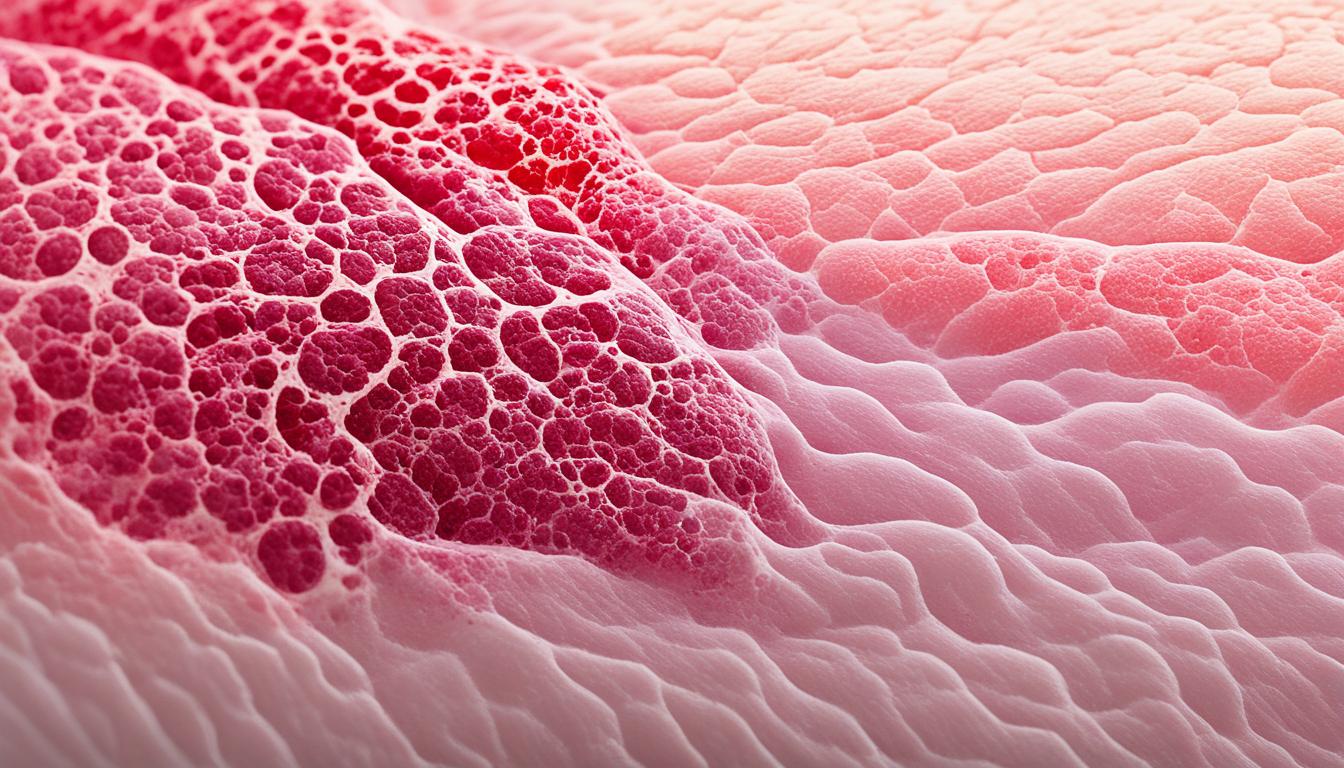Atopic dermatitis, also known as atopic eczema, is a chronic inflammatory skin condition. It leads to eczematous lesions with severe itching. This disorder is common, especially in children and infants around the globe.
The cause of atopic dermatitis is still not entirely known. But experts think it’s a mix of genetic factors, skin barrier defects, and immune system issues. Treatments often include topical medications. Yet, using these medicines for a long time can have harmful effects and cause drug resistance.
Stem cell therapy, especially involving mesenchymal stem cells (MSCs), shows promise in treating atopic dermatitis. MSCs have the unique ability to repair damaged tissues and control the immune system. They are a good fit for handling skin conditions related to inflammation and allergies, such as atopic dermatitis.
Key Takeaways:
- Atopic dermatitis is a chronic inflammatory skin condition characterized by eczematous lesions and severe itching.
- The exact cause of this condition is not fully understood, but it is believed to involve genetic factors, epidermal barrier defects, and immune system abnormalities.
- Topical medications are commonly used for treating atopic dermatitis, but their long-term use can have adverse effects and lead to drug resistance.
- Recent research has shown promising results in the use of stem cells, specifically mesenchymal stem/stromal cells (MSCs), for the treatment of atopic dermatitis.
- MSCs have the ability to repair tissues and modulate the immune system, making them a potential therapeutic option for inflammatory and allergic skin disorders.
Understanding Atopic Dermatitis: Prevalence, Symptoms, and Pathogenesis.
Atopic dermatitis is a widespread skin issue, known to many as atopic eczema. It impacts over 20% of children and between 1 to 10% of adults globally. This condition leads to inflamed skin, severe itching, and a weakened skin barrier.
The cause of atopic dermatitis involves genes, issues with the skin’s outer layer, and immune factors. Inflammation, driven by cytokines like interleukins, sets off the disease. This process leads to the persistent symptoms of atopic dermatitis.
Atopic dermatitis signs change with age. Infants show symptoms like redness and small blisters on the face and scalp. Adults may have these symptoms in tucked body areas and beyond. The disease can start in childhood and continue into grown-up years for some.
Eczema Symptoms
Common symptoms of atopic dermatitis are:
- Redness and inflammation of the skin
- Severe itching (pruritus)
- Dry and scaly skin
- Oozing or crusting of the affected areas
- Thickening of the skin (lichenification)
People with this condition face periods where it flares up and then gets better again. Many things, like allergens or stress, can make the condition worse. These triggers can also start the disease initially.
Prevalence of Atopic Dermatitis
Millions are affected by atopic dermatitis worldwide. Its numbers are growing, especially in places with better living standards.
About 20% of kids and up to 10% of adults experience this issue. It usually starts in kids, but adults can develop it too. This could be a continuation from childhood or appear later in life.
Understanding Pathogenesis
The causes of atopic dermatitis are a mix of genes, immune system behavior, and outer influences. While its exact origin is not completely clear, researchers have found many gene types that might lead to it.
Those with atopic dermatitis have an immune system that overreacts, causing ongoing inflammation. This over-reaction makes the skin’s protective layer weak. It also ramps up the body’s allergic reactions by boosting IgE antibodies.
| Age Group | Symptoms |
|---|---|
| Infants | Erythematous papules and vesicles on the cheeks, forehead, neck, and scalp |
| Children | Eczematous lesions in flexural folds, face, neck, and other areas of the body |
| Adults | Eczema in flexural folds, face, neck, and other areas of the body |
Learning about atopic dermatitis’ spread, its signs, and underlying causes is key to treating it well. By targeting the root issues and aiming to reduce swelling, patients can expect better skin and an improved life quality.
Stem Cell Therapy for Atopic Dermatitis: The Potential and Challenges.
Scientists are looking into new ways to treat atopic dermatitis. They find hope in mesenchymal stem/stromal cells (MSCs). MSCs come from many places like bone marrow and umbilical cord. They show great ability to work with the immune system. This helps to lower inflammation in skin diseases like atopic dermatitis.
Tests in labs and on people show that MSCs may help treat atopic dermatitis. They target the problem in the immune system. MSC therapy is showing good signs of reducing skin inflammation and easing symptoms. But, there are still steps to take before this therapy is widely used.
Making a standard way to isolate MSCs is a big challenge. We need to set clear methods for getting, growing, and checking MSCs. This is key to making sure the treatment works the same every time. Figuring out the best amount to use and how it works exactly are also important.
Stem cell therapy for atopic dermatitis has a bright future but needs more study. We must sort out these challenges and perfect the way we use it. This can lead to treatments that help atopic dermatitis patients for a long time.

